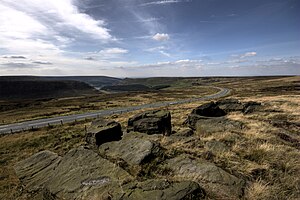Saddleworth Moor
| Saddleworth Moor | |||
| Yorkshire | |||
|---|---|---|---|
 Saddleworth Moor towards Dovestone Reservoir | |||
| Range: | Pennines | ||
| 53°32’36"N, 1°57’21"W | |||
Saddleworth Moor is an area of the South Pennines in the West Riding of Yorkshire. It is within the Dark Peak area of the Peak District National Park. The land reaches over 1,312 ft above sea level. It is crossed by the A635 road and the Pennine Way passes to its eastern side.[1][2]
Geography
The moor takes its name from Saddleworth to the west. The moorland is an elevated plateau with gritstone escarpments or edges and, around its margins, deeply incised v-shaped valleys or cloughs with fast-flowing streams. (Clough is derived from the Old English cloh which means a deep valley or ravine.[3]) The overlying peat is cut by drainage channels or groughs. The high moorland is sparsely inhabited. Scattered farmsteads, built of local gritstone, and fields demarcated by dry stone walls are on the lower land and in the valleys where there is some coniferous woodland. Much of the area is open access land.[2]
The landscape is traversed by an A road between the conurbations in southern Lancashire and western Yorkshire. The A635 road, known locally as the Isle of Skye road, passes across the moor taking its name from a former public house at Wessenden Head which was demolished after a fire. The Pennine Way arrives from the Wessenden Valley to the north and crosses the moor on its ascent to Black Hill on Holme Moss to the south.
Vegetation
Blanket bog in the area is the most south-easterly occurrence in Europe. Cottongrass is the most dominant feature and sphagnum mosses scarce. Heather, crowberry, bilberry and the rare cloudberry are also found. There are extensive areas of bare peat from which the surface has eroded. The peat formation is 9,000 years old.[4]
Reservoirs
Dovestone, Yeoman Hey, Greenfield and Chew Reservoirs east of Oldham, are accessed from the A635 road. The reservoirs supply water to the surrounding area. The valley is surrounded by rocky outcrops and moorland. Spruce and pine plantations are found in the valley and broad-leaved trees have been introduced to provide a more diverse habitat.[5]
Yeoman Hey was built in 1880 and Chew Reservoir was built in 1914, and when built, was the highest reservoir in the British Isles at 1,601 ft above sea level. The bed of the tramway, built to aid its construction remains visible. The area around the reservoir is used for recreation.[5]
References
Notes
- ↑ Peak District National Park, Peak District National Park Authority, http://www.peakdistrict.gov.uk/maps/pdmap, retrieved 20 July 2012
- ↑ 2.0 2.1 (pdf) Dark Peak, Natural England, p. 3, http://www.naturalengland.org.uk/Images/jca51_tcm6-4988.pdf, retrieved 20 July 2012
- ↑ Mills 1998, p. 402
- ↑ South Pennine Moors, Defra, http://jncc.defra.gov.uk/ProtectedSites/SACselection/sac.asp?EUcode=UK0030280, retrieved 21 July 2012
- ↑ 5.0 5.1 Dove Stone Reservoir, United Utilities, http://www.unitedutilities.com/dove-stone-reservoir.aspx, retrieved 21 July 2012
Bibliography
- Mills, A.D. (1998), A Dictionary of English Placenames, Oxford University Press, ISBN 0-19-280074-4